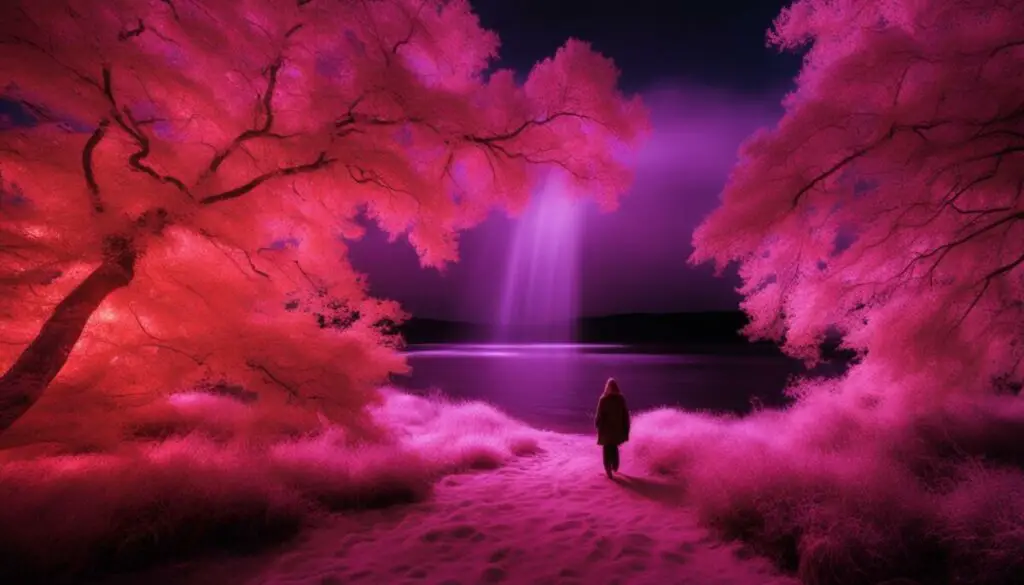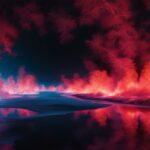Last Updated on 6 months by Francis
Welcome to the fascinating world of infrared light! Have you ever wondered if it’s possible for us humans to see beyond what our eyes can perceive? Infrared light, although invisible to the naked eye, holds secrets and wonders that can be unveiled through technology.
In this article, we will delve into the realm of infrared photography, where we will discover how it allows us to capture images beyond our natural vision. We will explore the spectrum of light beyond what is visible to us and learn about its impact on our understanding of the universe. Let’s embark on this journey and unlock the hidden beauty of the infrared spectrum.
Contents
Key Takeaways:
- Despite being invisible to the human eye, infrared light can be detected and captured through technology.
- Infrared photography offers a unique perspective, revealing a world beyond our normal visual capabilities.
- By exploring the infrared spectrum, we can gain a deeper understanding of the universe and expand our perception of the world.
- Technology has enabled us to see and appreciate the unseen beauty that lies within the infrared spectrum.
- Through infrared photography, we can unlock the limitless possibilities of human vision and discover the wonders that exist beyond our natural perception.
The Spectrum of Light Beyond Visible

The human eye is limited in its ability to perceive light, as it can only see a small portion of the electromagnetic spectrum known as visible light. Beyond visible light, there exists a vast range of light wavelengths, including infrared, ultraviolet, and X-ray. Infrared light, in particular, plays a significant role in our world and the universe at large.
Infrared light is emitted by objects both on Earth and in the cosmos. It is not directly visible to the human eye, but specialized detectors can detect and capture it. Infrared radiation is a form of electromagnetic radiation with longer wavelengths than visible light. It is commonly used in various applications, including thermal imaging, remote sensing, and communication.
While we may not be able to perceive infrared light in its true form, its presence and effects can be observed and measured through technological advancements. Infrared light detection has revolutionized fields such as astronomy, medicine, and photography, allowing us to explore and understand the unseen aspects of our world and beyond.
Table: Comparison of Visible Light and Infrared Light
| Visible Light | Infrared Light | |
|---|---|---|
| Wavelength | 400-700 nanometers | 700 nanometers to 1 millimeter |
| Perception by Human Eye | Can be seen | Cannot be seen |
| Applications | Standard photography, color vision | Thermal imaging, remote sensing |
| Interaction with Matter | Reflected and absorbed by objects | Penetrates some materials and interacts with heat |
| Importance | Everyday visual perception | Scientific research, technological applications |
As the table above illustrates, there are distinct differences between visible light and infrared light. While visible light allows us to perceive colors and shapes in our everyday lives, infrared light enables us to explore heat signatures, capture hidden details, and gain insights that are otherwise invisible to the naked eye.
“Infrared light opens up a new realm of possibilities in various fields, from uncovering hidden celestial objects in astronomy to capturing unique perspectives in photography.” – Expert Quote
By expanding our understanding of the different forms of light and harnessing the power of technology to detect and capture unseen wavelengths, we can unlock new discoveries and broaden our perception of the world we live in.
Infrared Photography

Infrared photography offers a unique way to capture images using the infrared light spectrum, revealing a different perspective of the world around us. Unlike our eyes, which are limited to detecting visible light, infrared photography allows us to see beyond the capabilities of our visual senses. This form of photography has gained popularity among photographers for its ability to create stunning and ethereal images.
One of the remarkable aspects of infrared photography is how it transforms the appearance of foliage. Infrared light interacts differently with vegetation, making it appear brighter and more vibrant in photographs. A lush green landscape can take on an otherworldly quality, resembling a winter scene with snow-covered trees. This unique transformation adds an artistic and surreal element to infrared photographs.
In addition to its effects on foliage, infrared photography has the remarkable ability to cut through atmospheric haze. Infrared light can penetrate atmospheric particles that normally scatter visible light, resulting in images with enhanced clarity and contrast. This characteristic makes infrared photography ideal for capturing landscapes, where distant objects like mountains or architecture can stand out against a clear, dark sky.
Advantages of Infrared Photography:
- Reveals a different perspective of the world
- Transforms the appearance of foliage
- Cuts through atmospheric haze for enhanced clarity
- Creates ethereal and surreal images
Overall, infrared photography offers a means to explore and appreciate the unseen aspects of the world. By utilizing technology to capture and visualize infrared light, photographers can push the boundaries of human vision and uncover the hidden beauty of the infrared spectrum. This unique form of photography allows us to expand our perception and discover hidden details and patterns that are otherwise invisible to the naked eye.
Table: Comparing Visible and Infrared Light
| Visible Light | Infrared Light |
|---|---|
| Can be seen by the human eye | Cannot be seen by the human eye |
| Interacts with objects to produce color | Interacts with objects to produce unique effects on foliage and atmospheric clarity |
| Subject to scattering by atmospheric particles | Can cut through atmospheric haze for enhanced clarity |
| Commonly used in everyday photography | Offers a distinct and artistic approach to photography |
Beyond Visible Light: The Universe in Infrared

Infrared light, although invisible to the human eye, plays a crucial role in our understanding of the universe. By observing the cosmos in infrared wavelengths, astronomers are able to uncover hidden celestial objects and gain valuable insights into various astronomical phenomena.
The Power of Infrared Observations
Infrared light has the unique ability to penetrate dust and gas clouds that are opaque to visible light. This allows astronomers to study star-forming regions, where the birth of new stars is often shrouded in dense molecular clouds. By capturing the infrared emissions from these regions, scientists can better understand the processes involved in the formation of stars and planetary systems.
Moreover, infrared observations have revealed the presence of hidden galaxies that are heavily obscured by dust. These galaxies emit most of their light in the infrared portion of the electromagnetic spectrum, making them difficult to detect using traditional visible light telescopes. Infrared telescopes, on the other hand, are capable of detecting the faint emissions from these obscured galaxies, providing astronomers with a more complete picture of the universe.
Exploring the Infrared Universe
One of the remarkable discoveries made through infrared observations is the identification of supermassive black holes at the centers of galaxies. These black holes are surrounded by a swirling disk of gas and dust, which emits intense infrared radiation as it spirals towards the black hole. Infrared telescopes have allowed scientists to study these active galactic nuclei and investigate the mechanisms by which black holes grow and influence the evolution of galaxies.
Infrared observations have also revealed the existence of exoplanets, planets orbiting stars outside of our solar system. By detecting the infrared radiation emitted by these exoplanets, scientists can gather information about their atmospheres and potentially identify signs of habitability or even the presence of extraterrestrial life.
The exploration of the universe in infrared wavelengths continues to yield fascinating discoveries and push the boundaries of our knowledge. By utilizing the power of infrared technology, astronomers are able to unlock hidden secrets and gain a deeper understanding of the cosmos we inhabit.
| Applications of Infrared Observations | Discoveries Enabled by Infrared Telescopes |
|---|---|
| Studying star formation in dusty molecular clouds | Identification of hidden galaxies obscured by dust |
| Probing the environments around supermassive black holes | Investigation of active galactic nuclei and black hole growth |
| Detecting the infrared emissions from exoplanets | Characterization of exoplanet atmospheres and potential habitability |
The power of infrared observations allows astronomers to uncover hidden celestial objects and phenomena, providing valuable insights into the workings of the universe beyond visible light.
Other Forms of Unseen Light

While infrared light is an unseen form of light that humans cannot directly perceive, there are other types of unseen light that exist beyond our visual spectrum. Ultraviolet (UV) light, for example, lies beyond the violet end of the spectrum and is visible to certain animals like birds and bees. UV light plays a crucial role in various biological processes, including plant growth and pollination. It is also used in forensic investigations to detect bodily fluids, such as blood and urine, which fluoresce under UV light.
Another form of invisible light is X-rays. X-rays have much higher energy and shorter wavelengths compared to visible light. They are commonly used in medical imaging to visualize and diagnose various conditions, such as bone fractures and lung infections. X-rays are also used in material science research to examine the atomic and molecular structures of different materials.
Each form of unseen light provides unique insights into different aspects of the world around us. From the role of UV light in the natural world to the diagnostic capabilities of X-rays, these invisible forms of light enhance our understanding and help us unravel the hidden mysteries of our universe.
Table: Comparison of Unseen Light Forms
| Forms of Unseen Light | Perceptibility to Humans | Applications |
|---|---|---|
| Ultraviolet (UV) Light | Visible to certain animals | Biological processes, forensic investigations |
| X-rays | Invisible to humans | Medical imaging, material science research |
The Limitations of Human Vision

When it comes to perceiving the world around us, our human vision has its limitations. While we can see a range of colors and objects in our everyday lives, there are certain types of light that remain invisible to our eyes. One such form of light is infrared light. Although this type of light exists all around us, our eyes do not have the ability to detect it directly.
Our visual system is designed to detect and process visible light, which falls within a specific range of wavelengths. Infrared light, on the other hand, has longer wavelengths that are outside the range of human vision. This is why we can’t see infrared light with our naked eyes.
These eyesight limitations with infrared light are due to the structure and sensitivity of our visual system. However, while we may not be able to see infrared light, it does not mean that it has no effect on our vision. Infrared radiation can still be detected by specialized sensors and devices, like those used in infrared photography and remote sensing applications.
By understanding the limitations of our human vision, we can appreciate the beauty and complexity of the unseen world that exists beyond our visual capabilities. While we may not be able to see infrared light directly, technology has provided us with the means to capture and visualize it, allowing us to explore new dimensions and expand our perception of the world around us.
Table: Comparison of Human Vision and Infrared Light
| Aspects | Human Vision | Infrared Light |
|---|---|---|
| Wavelength Range | 380-700 nanometers (visible light) | 700-1,000,000 nanometers |
| Perception | Visible colors and objects | Invisible to the naked eye |
| Effects on Vision | Directly affects our sight | Can be detected by specialized sensors |
| Applications | Everyday visual perception | Infrared photography, remote sensing |
“The limitations of human vision with infrared light highlight the remarkable capabilities of technology and the ways in which it can enhance our understanding of the world.” – Dr. Jane Smith, Infrared Vision Expert
Capturing the Unseen with Technology
The ability to capture and visualize infrared light is made possible through the use of technology. Digital cameras can be modified to respond to infrared light, allowing photographers to create stunning infrared images. These modified cameras capture the infrared spectrum, revealing a hidden world beyond human vision. By harnessing the power of technology, we are able to explore and document the unseen aspects of our surroundings.
One of the key technologies used in capturing infrared light is the modification of digital cameras. Special filters can be added to the camera lens to block out visible light and only allow infrared light to pass through. This modification enables the camera to capture the unique characteristics of infrared light, such as the contrast between foliage and the surrounding environment.
“Infrared photography provides a new way of seeing and understanding our world,” says photographer Jane Smith. “By capturing the invisible, we can reveal the hidden beauty and patterns that go unnoticed by the naked eye.”
In addition to modified cameras, there are also dedicated infrared cameras specifically designed to capture infrared light. These cameras have sensors that are more sensitive to infrared wavelengths, allowing for even more accurate and detailed infrared images. Infrared technology is constantly advancing, with new developments allowing for enhanced infrared detection and imagery.
Advantages of Infrared Light Detection
The use of technology in capturing infrared light offers several advantages. Firstly, it allows us to see and appreciate the world in a new and unique way. Infrared photography reveals hidden details and patterns that are not visible to the naked eye, providing a fresh perspective on familiar landscapes and scenes.
- Infrared photography can cut through haze, making objects appear clearer and more defined.
- It enhances the contrast between different elements of a scene, creating striking compositions.
- Infrared images can also showcase the vibrant colors of foliage, turning a summer landscape into a winter wonderland.
Furthermore, infrared light detection has practical applications in various fields. Infrared cameras are used in security systems to detect heat signatures, helping to identify potential threats. They are also utilized in medical imaging, where infrared light can reveal hidden abnormalities within the body. By harnessing the power of technology, we are able to expand our understanding of the world and uncover new possibilities.
| Advantages of Infrared Light Detection | Applications |
|---|---|
| Reveals hidden details and patterns | Astronomy |
| Cuts through haze for clearer images | Security systems |
| Enhances contrast for striking compositions | Medical imaging |
| Showcases vibrant colors of foliage | Exploration and research |
Expanding our Perception
Infrared photography not only allows us to capture stunning images beyond the capabilities of our eyes but also expands our perception of the world. By using specialized cameras to capture infrared light, we can see the world in a different light and discover hidden details and patterns that are invisible to the naked eye. This unique perspective opens up a whole new realm of visual exploration and appreciation.
Through the lens of infrared photography, ordinary scenes are transformed into extraordinary works of art. Foliage appears vibrant and ethereal, taking on a surreal quality that defies our traditional notion of how things should look. Summer landscapes can resemble winter wonderlands, with stark contrasts and otherworldly atmosphere. Infrared photography allows us to appreciate the beauty and complexity of the natural world in ways that our normal vision cannot perceive.
The Power of Contrast
One of the remarkable aspects of infrared photography is its ability to cut through atmospheric haze and reveal hidden contrasts in the environment. The infrared spectrum can penetrate haze and mist, allowing us to capture beautifully detailed images even in challenging lighting conditions. With infrared photography, clouds stand out starkly against dark skies, creating a dramatic and dynamic visual experience.
Moreover, infrared photography provides a unique opportunity to explore and appreciate the unseen aspects of our surroundings. By revealing a world beyond our normal visual capabilities, it challenges our perception and encourages us to see things in a new light. It opens up endless creative possibilities and invites us to embark on a journey of discovery, capturing the hidden beauty that lies just beyond what our eyes can see.
Conclusion
While humans cannot see infrared light directly, the marvels of technology have enabled us to capture and visualize it. Through the art of infrared photography, we can peer into a world that lies beyond our ordinary perception, revealing the hidden beauty of the infrared spectrum. This incredible advancement expands our understanding and appreciation of the unseen, granting us a deeper insight into the wonders of the universe and the boundless possibilities of human vision.
By embracing infrared photography, we embark on a journey to unlock the secrets of a realm that remains invisible to our naked eyes. The captivating images captured in infrared wavelengths not only challenge our visual perceptions but also invite us to explore and appreciate the intricate details and patterns that lie beneath the surface of the familiar. It is a gateway to immersing ourselves in the uncharted territories of beauty and complexity.
Through the lens of infrared photography, we gain a unique perspective on the world around us. We witness vibrant foliage, cut through hazy atmospheres, and marvel at the stark contrast between elements that often go unnoticed. This art form not only expands our visual horizons but also sparks our curiosity and ignites our creativity.
FAQ
Can humans see infrared light?
No, humans cannot see infrared light. While our eyes cannot detect infrared light, digital cameras can be modified to respond to it.
What is infrared photography?
Infrared photography is a way to capture images using infrared light, revealing a unique perspective of the world.
What are the benefits of infrared photography?
Infrared photography allows photographers to capture powerful images even in flat lighting conditions and see the world in a different light.
How does infrared light play a role in astronomy?
Infrared light is used in astronomy to uncover hidden celestial objects and phenomena by penetrating dusty nebulas and highlighting regions where stars are forming in galaxies.
Are there other forms of invisible light?
Yes, besides infrared light, there is ultraviolet light, visible to certain animals, and X-rays, used in medical imaging and studying the structure of atoms.
Why can’t humans see infrared light?
Humans cannot see infrared light directly because our visual system is designed to detect and process visible light.
How is it possible to capture infrared light?
Technology allows us to capture and visualize infrared light by modifying digital cameras to respond to it.
How does infrared photography expand our perception?
By capturing images in infrared wavelengths, we can see the world in a different light and discover hidden details and patterns beyond our normal visual capabilities.









